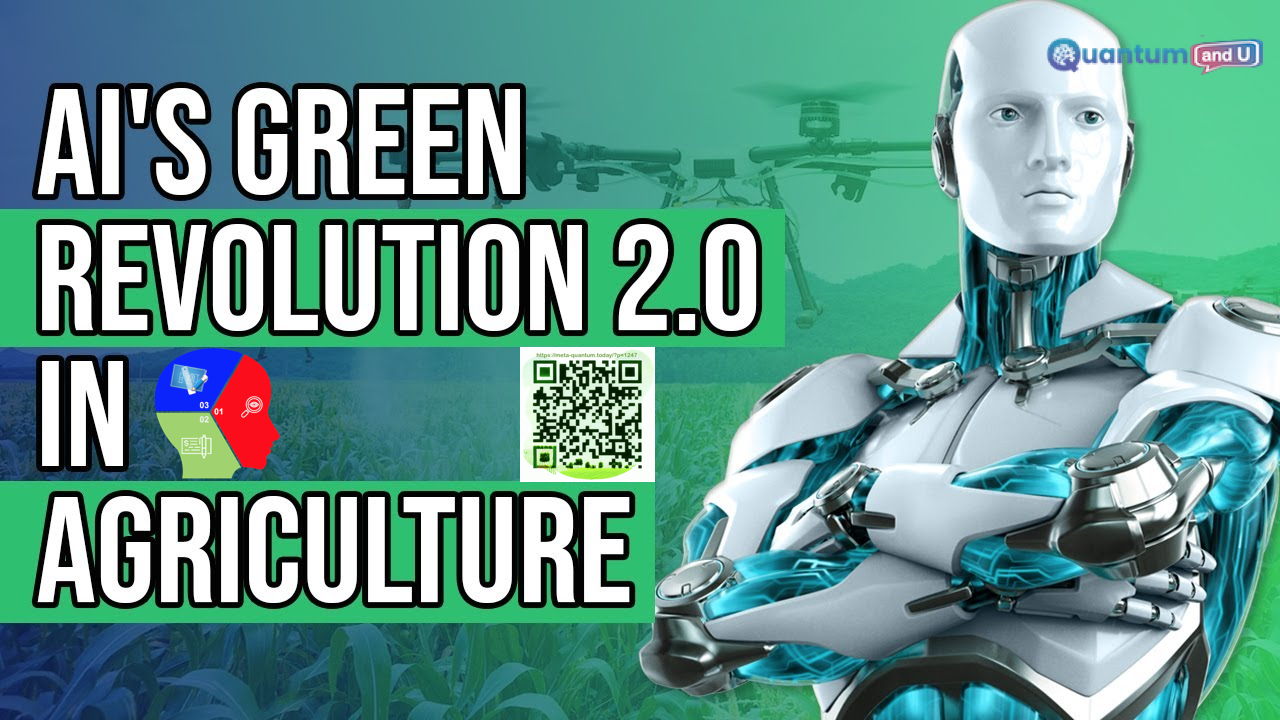
Introduction:
In this YouTube review titled “AI in Agriculture: The Green Revolution 2.0 – Enhancing Modern Farming with Artificial Intelligence,” we delve into the groundbreaking fusion of technology and agriculture. As the global population is projected to reach 9.7 billion by 2050, the challenges of food production become increasingly daunting. However, artificial intelligence (AI) offers a promising solution by transforming the way we approach farming.
Market size of AI in agriculture:
The market size of AI in agriculture in Southeast Asia is estimated to be USD 2.3 billion by 2025, growing at a CAGR of 20%. This growth is being driven by the increasing adoption of AI-powered solutions by farmers and agricultural businesses to improve crop yields, reduce costs, and mitigate the effects of climate change.
Some of the key AI-powered solutions that are being used in Southeast Asia agriculture include:
- Precision farming: This uses data analytics and machine learning to optimize crop production by tailoring inputs such as water, fertilizer, and pesticides to the specific needs of each field.
- Robotics: Robots are being used for a variety of tasks in agriculture, such as weeding, harvesting, and packing produce.
- Image recognition: This is used to identify pests and diseases in crops, as well as to monitor crop health.
- Drones: Drones are used for a variety of tasks in agriculture, such as surveying fields, spraying pesticides, and delivering seeds and fertilizer.
The adoption of AI in agriculture is still in its early stages in Southeast Asia, but the market is expected to grow rapidly in the coming years. This is due to the increasing availability of data, the falling cost of sensors and computing power, and the growing awareness of the benefits of AI among farmers and agricultural businesses.
Here are some of the factors that are driving the growth of the AI in agriculture market in Southeast Asia:
- Growing population: The population of Southeast Asia is expected to reach 725 million by 2030, putting a strain on food production. AI can help farmers to increase crop yields and improve food security.
- Declining agricultural workforce: The agricultural workforce in Southeast Asia is declining due to urbanization and aging. AI can help to fill this gap by automating tasks and making farming more efficient.
- Climate change: Climate change is posing a major challenge to agriculture in Southeast Asia. AI can help farmers to adapt to climate change by developing more resilient crops and farming practices.
The growth of the AI in agriculture market in Southeast Asia presents a number of opportunities for businesses. Some of the key opportunities include:
- Developing and providing AI-powered solutions for farmers and agricultural businesses.
- Providing training and support to farmers on how to use AI-powered solutions.
- Conducting research and development in AI for agriculture.
- Investing in startups that are developing AI-powered solutions for agriculture.
The AI in agriculture market in Southeast Asia is a rapidly growing market with a lot of potential. Businesses that are able to capitalize on this market will be well-positioned for success.
Related Sections:
- AI-Powered Crop Monitoring: The video provides an in-depth discussion on drones and robots in the field of agriculture. The use of these technologies has revolutionized farming practices, enabling farmers to effectively monitor crops and identify potential issues such as pest infestations and nutrient deficiencies. By using machine learning algorithms, farmers can easily analyze large volumes of data, providing them with accurate and timely insights on the status of their crops. Additionally, these technologies have enabled farmers to optimize various farming activities, leading to healthier crops and higher yields. With the continuous advancement of technology, it is expected that drones and robots will play an even more significant role in the field of agriculture in the years to come.
- Smart Irrigation: Traditional irrigation methods have long been a source of concern due to their tendency to result in over- or under-irrigation. This not only wastes water, but can also lead to negative impacts on plant health. However, with the advent of AI-controlled systems, we can now adjust water delivery in real-time to ensure optimal irrigation levels. This not only conserves water, but also helps to reduce energy consumption, making it a win-win situation for farmers and the environment.
- Resource Management: Artificial intelligence (AI) can enhance agricultural efficiency and sustainability. It reduces fertilizer usage by up to 30%, preventing water pollution, soil degradation, and greenhouse gas emissions. AI also helps farmers make data-driven decisions by analyzing crop, soil, and weather data. These benefits promote sustainable farming practices and ensure long-term agricultural viability.
- Crop Selection and Disease Prevention: AI aids in selecting the right crops and hybrid seeds by analyzing data on weather conditions and soil types, reducing the risk of plant diseases. Farmers can meet market trends and maximize crop yields, leading to improved profitability.
- Labor Efficiency: AI-powered machinery has revolutionized the agriculture industry by introducing automated planters and harvesters. These machines can work tirelessly without the need for manual labor, particularly during peak seasons when farmers require extra hands to manage their crops. As a result, the use of AI machinery enhances crop health and ensures more effective farm management. This technology has also addressed the issue of labor shortages in the agriculture industry, allowing farmers to focus on other tasks such as maintenance, crop rotation, and other farm-related activities. In addition, the use of AI machinery has reduced the physical strain on farmers who no longer have to endure long hours of manual labor, which in turn promotes better health and wellbeing. Finally, the integration of AI into agriculture also promotes sustainable farming practices, ensuring that farmers can produce crops in an environmentally friendly manner.
- Attracting Youth to Agriculture: AI is revolutionizing the farming industry and making it more appealing to younger generations who are looking for ways to reduce physical labor and incorporate modern technology into their work. With the increasing trend of urbanization, it is important to ensure that the farming industry can keep up with the needs of a growing population. AI can help achieve this by increasing efficiency, reducing waste, and improving crop yields. By utilizing AI technology, farmers can also gain deeper insights into their crops and make better decisions about planting, harvesting, and managing their resources. This not only benefits farmers but also consumers by ensuring a steady supply of high-quality produce. Overall, the integration of AI into the farming industry is a positive step towards a more sustainable and efficient future.
- Climate Resilience: AI climate resilience systems can be incredibly useful in mitigating the effects of climate change. These systems have the ability to proactively assess potential climate impacts, allowing for adjustments in farming practices and infrastructure to withstand changing weather patterns and reduce vulnerabilities. By identifying areas that may be most affected by climate change, these systems can help farmers and communities prepare for potential disasters and adapt their practices to minimize negative effects. Furthermore, the technology behind these systems can be continuously improved and updated as more data is collected, ensuring that they remain effective and relevant in the face of ongoing changes in the climate. In short, AI climate resilience systems are an important tool in the fight against climate change, one that can help us better understand and prepare for the challenges of a rapidly changing world.
Conclusion with Takeaway Key Points:
In conclusion, artificial intelligence is revolutionizing modern agriculture in remarkable ways. It offers solutions to the challenges of feeding a growing global population while minimizing environmental impacts and increasing sustainability. The key takeaways from this review include:
- AI-driven crop monitoring improves crop health and yields.
- Smart irrigation conserves water and reduces energy consumption.
- AI promotes resource management and soil health.
- Crop selection and disease prevention enhance profitability.
- AI reduces the need for manual labor and improves farm management.
- AI makes farming more attractive to the younger generation.
- AI enhances climate resilience in agriculture.


